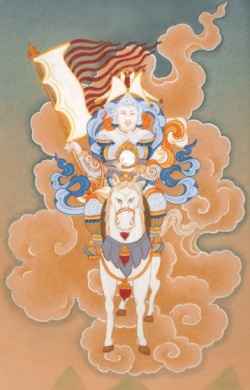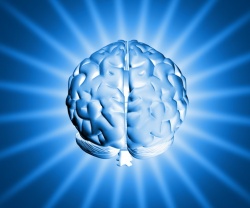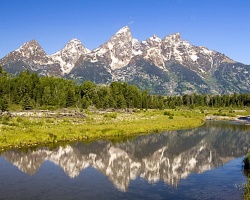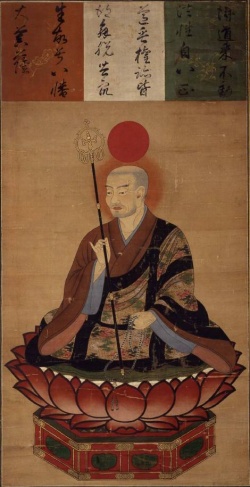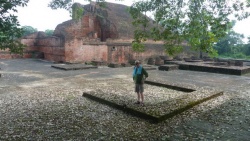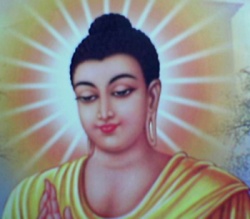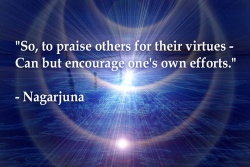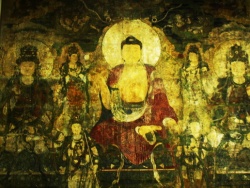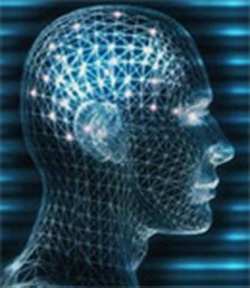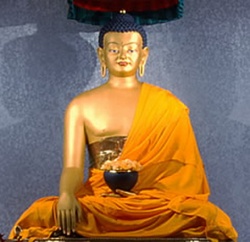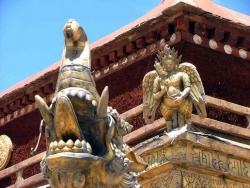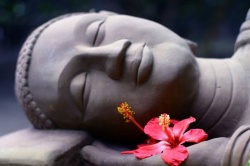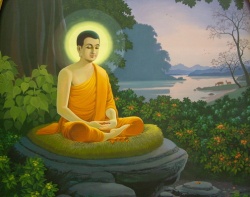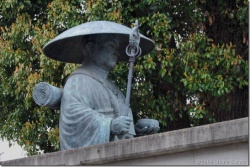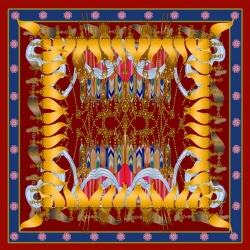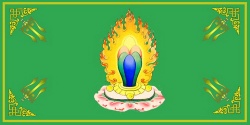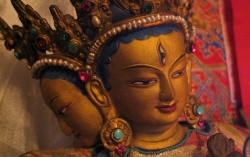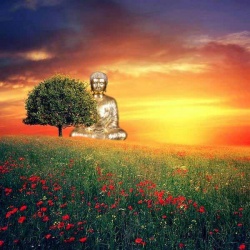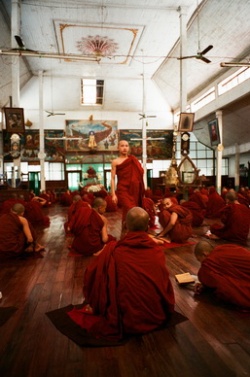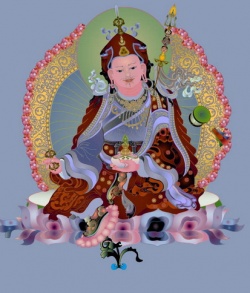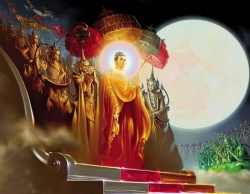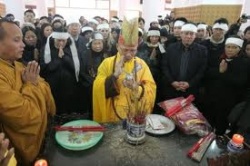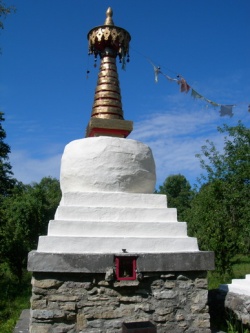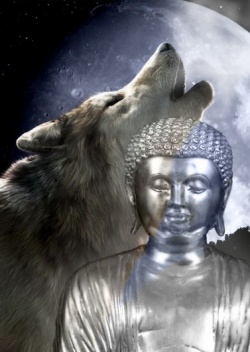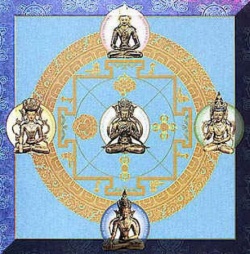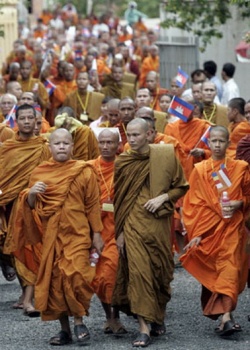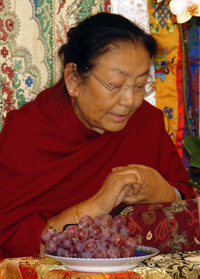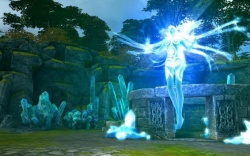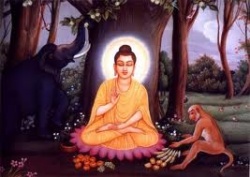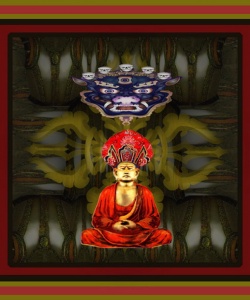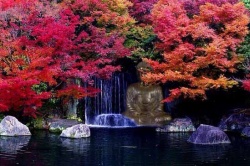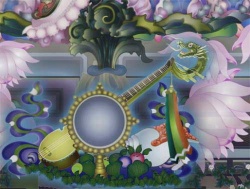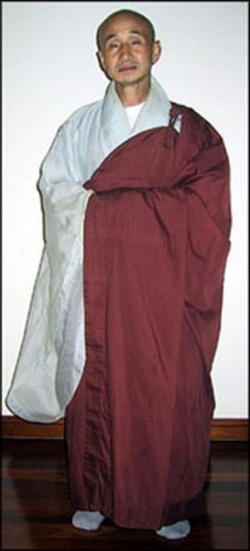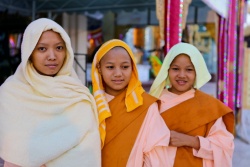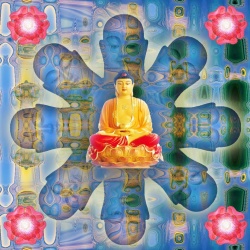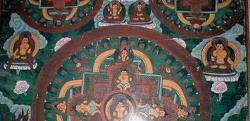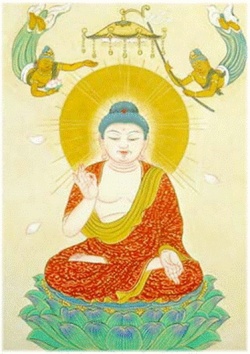The 31 Planes of Existence
(A brief guide to the Buddhist Universe, describing the various beings transmigrating in Samsara, and the strange environments they may find themselves in.
The article is intended for inclusion in the Player's Guide to a Buddhism-inspired board game called "Divine Play.")
The Buddhist cosmos represents a variation on the cosmology of ancient India.
Although human existence seems relatively advanced to us, in the Buddhist system the plane occupied by human beings is fifth from the bottom.
This is mainly because the Hell Realms are all combined together into one plane, while the Heaven Realms are divided up and reckoned separately; but even if the Hell Realms were divided up likewise we humans would still be closer to the bottom than the top.
The 31 planes, or Realms, starting from the bottom, are as follows.
1. Hell (Niraya)
There are many Hell Realms, usually described as very hot and very unpleasant.
Although an existence in none of the 31 Planes lasts forever, existence in the Hell Realms, like existence in the Heaven Realms, lasts for a long time.
In the Kokāliya Sutta of the Sutta Nipāta it is said that if there were a large cartload of sesame seeds, and one seed were taken from that cartload every century,
then all the seeds would be removed before one lifetime in the Abbuda Hell was exhausted.
Furthermore, a lifetime in the Nirabbuda Hell lasts 20 times longer than that;
one in the Ababa Hell 20 times longer still; one in the Ahaha Hell 20 times longer still;
and likewise down the series of Aṭaṭa Hell, Komuda Hell, Sogandhika Hell, Uppalaka Hell, Puṇḍarīka Hell, and Paduma Hell.
And at the very bottom, worst of all and lasting the longest, is a Hell called Avīci, which is said to have the walls, floor, and ceiling composed of red-hot iron.
The Discourse on the Divine Messengers (Devadūta Sutta, discourse number 130 in the Majjhima Nikāya) gives a great deal of grisly detail on the tortures of the Great Hell Avīci, for example:
Now the Hell-keepers torture [that being] with a torture called "the quintuple nailing"—they drive an iron spike through one hand; then they drive an iron spike through the other hand;
then they drive an iron spike through one foot;
then they drive an iron spike through the other foot;
then they drive an iron spike through the middle of his chest…then the Hell-keepers lay him down and chop him with axes…
then they make him climb up and down a great mountain of burning embers, flaming and blazing hot…then they throw him, feet up and head down,
into a red-hot metal cauldron, burning, flaming, and blazing hot…
There he feels feelings that are painful, sharp, racking, and harsh, but he does not die so long as that evil karma [that landed him there] has not been exhausted…
There comes an occasion…at some time or another, after a long time has elapsed, when the eastern door of the Great Hell is opened.
He runs to it as fast as he can; and while running as fast as he can his outer skin burns, his inner hide burns, his flesh burns, his tendons burn, and his bones smolder…[but] he escapes through that door.
Right next to the Great Hell is a huge Hell of Dung.
He falls into that.
And there in that Hell of Dung creatures with mouths like needles bore through his outer skin; having bored through his outer skin they bore through his inner hide;
having bored through his inner hide they bore through his flesh;
having bored through his flesh they bore through his tendons;
having bored through his tendons they bore through his bones;
and having bored through his bones they chew up his marrow…
Right next to the huge Hell of Dung is a huge Hell of Burning Coals. He falls into that…
Right next to the huge Hell of Burning Coals is a huge forest of thorn trees several miles high, with thorns a foot long, burning, flaming, and blazing hot, and they make him climb up and down them…
Right next to the huge forest of thorn trees is a huge forest of trees with leaves like swords. He goes into that…
Right next to the huge forest of sword-leaf trees is a huge river of scalding water. He falls into that…
Then the Hell-keepers pull him out with a hook…and throw him into the Great Hell again.
Despite all the badness, when one's bad karma has finally been burned up, one passes away from Hell and is reborn somewhere else.
2. {Demon Realm (Asura-Loka)
The Asuras of the ancient Indian system correspond to the Titans of ancient Greek mythology.
Apparently the prehistoric Indo-European peoples had a legend of a great war between the Gods and Titans over the rulership of this world.
The Gods defeated the Titans and imprisoned them under a mountain, with the Gods living on top of the same.
The Greeks chose Mount Olympus for the exalted home of the Gods and prison for the Titans; the Indians chose Meru,
the tallest mountain in the world, which they located among the Himalayas.
The Asuras are mentioned seldom in the early Buddhist texts,
but occasionally some of them break loose and cause trouble for the Gods, or Devas, and sometimes for humans also.
They have very large bodies and a reputation for arrogance, anger, and violence, as well as a pronounced dislike for the Devas.
Presumably their foul tempers plus their antagonism to the Gods (not to mention the fact that they lost the war) cause them to be ranked as subhuman.
These Demons should not be confused with the Hell-Keepers who torture the beings in Hell.
The latter, according to some Commentary or other, are actually not conscious beings at all, but a kind of materialization of the tortured beings' unwholesome karma.
3. Animal Realm (Tiracchāna-Yoni or Tiracchāna-Loka)
This Realm includes beings ranging from the tiniest insects up through apes, elephants,
and whales, and even includes more or less mythological creatures such as Nāgas (intelligent, shape-shifting cobra dragons) and Garuḷas (also called Garuḍas or Supaṇṇas—huge birds of prey also endowed with approximately human intelligence).
Though the life of a pampered housecat or a dragon may seem rather nice, life as an animal is considered to be inferior to life as a human mainly because, it is said, animals, regardless of their intelligence, are unable to cultivate wisdom and become Enlightened.
Also, of course, the life of most animals is brutish and unpleasant,
and often accompanied by much hunger and fear. Lifespans in the Animal Realm are generally much shorter than in other Realms (the life of an insect may last only a few weeks),
but transmigrating beings escape from this Realm with great difficulty due to their inability to cultivate wisdom there, and also the lack of morality,
with the corresponding gain of bad karma, that many animals necessarily have—mosquitoes, tigers, billy goats, etc.
A human being who lands here after death usually does so from having an animalistic mind before death.
4. Ghost Realm (Peta-Loka or Peta-Visaya)
The beings in this Realm are sometimes called Hungry Ghosts, mainly because of the ancient Indian tradition of ancestor worship.
Indian persons had (and some still do have) the sacred duty of revering the spirits of their departed ancestors and making offerings of food to them.
If an ancestral spirit did not receive such offerings, through the impiety or negligence of his or her descendants, or through not having any descendants,
then he or she was believed to exist in a state of hunger and wretchedness.
Later on, Hungry Ghosts were portrayed as having tiny mouths and huge stomachs, or huge mouths and tiny stomachs, or having severe eating disorders like being able to eat only very disgusting substances.
However, this Realm is also inhabited by beings who in their previous life were very virtuous yet had some stain of vice, so that they live almost like minor Gods or Goddesses, except for some karmic punishment which plagues them.
A remarkable example of this is a case (Petī Kaṇṇamundā Vatthu) found in the Peta-Vatthu and its commentary, of a woman who was very virtuous and made many donations to Buddhist monasteries, yet who was unfaithful to her husband on one occasion and, worse than that, swore a false oath to conceal the fact from him.
After death she was reborn as a female "Mansion Ghost" in possession of a large, beautiful palace in a valley of the Himalayas.
The palace was surrounded by a magnificent park filled with celestial fruit trees, flower gardens, and lotus pools. She was attended by hundreds of lovely maidens and remained beautiful and young-looking for centuries.
This was the karmic reward for her past virtue and generosity.
But, she also suffered two punishments: first, there were no males to keep her company in this paradise,
neither God nor man; and second, every night a large black dog tore the flesh from her body and ate it, shortly after which her flesh grew back good as new until the next evening.
Finally, after centuries of this, her bad karma was exhausted, the dog was killed, and she continued her existence in the palace as a Terrestrial Goddess (see Realm 6)—and she even got to have a boyfriend.
With all due respect to unrevered ancestral spirits and Mansion Ghosts,
the inhabitants of the Ghost Realm are generally considered to have had in their previous life some great attachment—to their home, to someone close to them, to their house, property, or money, or to their own body.
This accounts for why cemeteries may be haunted by spirits:
they are still identified with and attached to a decomposing body lying underground there.
(Consequently, some say it is better to have one's body cremated instead of buried after death, to reduce the chances of being reborn as a ghost haunting a grave.)
Though they are often called Ghosts or Spirits in English, Petas, or "the Departed," are not bodiless spirits,
but have a material form which may be described as "vibrating at a cruder frequency" than our own physical forms.
Consequently, humans and Petas usually cannot see each other even if they are in the same place.
5. Human World (Manussa-Loka)
This Realm is relatively self-explanatory, as most of the players of this Game are inhabitants of it, and thus have some familiarity with it.
Even so, some important spiritual qualities of the Human World should be emphasized here.
While beings in the Lower Realms are wallowing in misery and/or ignorance, and beings in the Higher Realms are wallowing in luxury and/or celestial bliss,
we humans experience enough misery in our lives to be inspired to strive for Liberation from it, and have enough wisdom to realize that Liberation.
That is why Buddhas appear especially at this level of existence, and establish the Sangha of those intent upon Enlightenment.
The wisest humans throughout history have taught from their own experience that it is possible to attain Full Enlightenment in this world,
and in this lifetime; and since Enlightenment is the best, noblest, and happiest of all states, it is definitely worth our while to make a dedicated effort to attain it—don't you think?
Hard it is to obtain a life as a human,
Hard is the life of mortals,
Hard the opportunity to hear the True Dharma,
And hard indeed to be there when Buddhas arise. (—Dhammapada, verse 182)
Get up! Sit up! Train steadfastly for peace.
Let not the King of Death, knowing you to be careless,
Delude you so that you are come under his power. (—Sutta Nipāta, verse 332)
6. Realm of the Four Great Kings (Catumahārājika Deva-Loka)
This is the lowest of the Realms inhabited by beings called Devas, often translated as "Gods," although it is not necessarily a Heaven Realm, as many or most of these beings dwell upon the surface of the earth, with large numbers of them inhabiting the slopes and foothills of Mount Meru.
The Four Great Kings are the divine guardians of the four quarters of the earth—Dhataraṭṭha in the east, Virūḷhaka in the south, Virūpakkha in the west, and Kuvera in the north.
In addition to the Great Kings and their retinues, this Realm also includes such beings as Gandhabbas (in Sanskrit, Gandharva),
pixie-like beings who are skilled in playing music and have the power to fly through the sky,
and Rakkhasas (Sanskrit Rākṣasaḥ), a kind of super-demon made famous by the villain of the Hindu epic Ramayana, the 10-faced Rākṣasaḥ king Ravana.
Also inhabiting this Realm are Yakkhas, which in later Buddhist tradition are portrayed as man-eating ogres and ogresses, but may have begun as the aboriginal deities worshipped in India at the time the Sanskrit-speaking Indo-Aryans invaded and conquered the country.
The Indo-Aryans had their own deities and were not much inclined to worship those of the conquered peoples, but they were not audacious enough to declare them completely nonexistent either.
So, they played it safe by attributing a status to the Yakkhas higher than the human level, yet not so high as the Gods and Goddesses of the Indo-Aryan pantheon.
Many of the beings in this Realm are terrestrial nature "spirits" such as tree-Devas, as well as powerful guardians of forests, rivers, ancient temples, and so forth.
Beings in European folklore like elves and fairies presumably would also be inhabitants of this level.
7. Realm of the 33 Gods (Tāvatiṁsa Deva-Loka)
This was considered to be Heaven Proper in early Vedic times, and is the abode of important Vedic deities like Varuna and Prajapati, as well as primitive versions of the great Hindu Gods Shiva and Vishnu.
Tāvatiṁsa Heaven is located at the top of Mount Meru (the tallest mountain in the world), and is ruled by Sakka, King of Gods.
Sakka was originally better known as Indra "Smasher of Fortresses," the patron deity of the early Indo-Aryan invaders; but with the advent of the Buddha he converted to Buddhism, began favoring the name Sakka, and before long became a Buddhist saint.
There have come to be many more than 33 deities dwelling there, and they are renowned for their great beauty and longevity, and the great opulence and luxury in which they live their lives.
Each God lives in a huge, magnificent palace accompanied by hundreds of celestial Nymphs—whether Goddesses have corresponding harems of beautiful God-boys is uncertain.
They may occasionally have trouble with the Asuras, whom they defeated in a great war long ago (see Realm 2),
but they spend most of their time happily, feasting, enjoying music, and dallying in the pleasure-parks located throughout Tāvatiṁsa, the most famous of which being Nandavāna, "The Grove of Delight."
Yakkhas and tree-Devas may be born from a mother's womb and go through an extended time of infancy, but Deities appear spontaneously as young adults in Tāvatiṁsa and higher Realms.
And though there is no sickness or old age there, no state of being lasts forever; so after a lifespan of some 35-40 million years,
when the karma maintaining them there is exhausted, their radiant glory fades, and they pass away from there to some other place, according to their karma.
It is said that during one Indian monsoon season the Buddha stayed in Tāvatiṁsa and taught Buddhist philosophy to the Gods and Goddesses assembled there.
8. Realm of the Destroyer Gods (Yāma Deva-Loka)
Reliable information on this Heaven Realm is hard to come by, and it is mentioned very rarely in the texts.
It might be supposed that this is the abode of Yama, Lord of the Afterworld and Judge of the Dead, famous, among other reasons, for his prominent role in the Katha Upanishad;
but the Theravadin commentarial tradition asserts that this Yama dwells in the Realm of the Four Great Kings (see Realm 6).
According to the commentaries they are called Destroyer Gods because they destroy pain and live in happiness.
Aside from their name and rank, and the additional information that they live in the sky, all that is certain is that the fortunate inhabitants of the Yāma Heaven live even more happily, and much longer, than the Gods and Goddesses of Tāvatiṁsa.
9. Realm of the Contented Gods (Tusita Deva-Loka)
This Heaven's primary claim to fame is that the Bodhisatta (the being destined to become Gotama Buddha) resided here in glory until the time was ripe to descend into the world and be reborn as a human in a family of the Sakya clan,
in the city-state of Kapilavatthu in what is now southern Nepal, in order to become the Buddha and "set the Wheel of Dharma in motion"
It is also said that the Buddha's parents ascended into this Heaven after their deaths, and thus are presumably still there now, as the average lifespan there is more than 500 million human years.
The Bodhisatta who is destined to become the next Buddha in this world is presently a Deva named Nātha residing in Tusita Heaven. Eventually, they say,
after Buddhism has completely degenerated and become extinct (as nothing lasts forever),
he will descend to earth to become the Buddha Metteyya, or in Sanskrit, Maitreya, and set the Wheel in motion again.
10. Realm of the Gods Who Delight in Creating (Nimmānarati Deva-Loka)
The exalted beings inhabiting this Realm are able to create their living environments with the power of mind.
For example, if they want to relax in the midst of a grove of celestial jewel trees, they surround themselves with celestial jewel trees with their own divine psychic power;
or if they wish to spend some time in a crystal palace overlooking a purple sea, they easily create one for themselves by the power of divine thought.
They have the same power over their own bodies, and can look however they please.
The Devas in less exalted Realms have this power to some degree also, and even humans and animals have some spark of it, but these beings appear to specialize in it.
11. Realm of the Gods Who Wield Power Over What Is Created by Others (Paranimmita-Vasavatti Deva-Loka)=
This is the highest Heaven inhabited by beings properly called Devas, and is the highest Realm in the World of Sensuality—the Kāma-Loka or Kāmāvacara.
In addition to having a more subtle, more blissful consciousness and a longer lifespan, these Devas are superior to the Nimmānarati Devas
in that they are spared the trouble of creating their own environments, as they have attendants (perhaps similar or identical to the Nimmānarati Devas) who do the creating for them.
One of the most remarkable features of this Heaven is that it is the abode of Māra the Buddhist "Devil," and his three voluptuous daughters Taṇhā (Craving), Arati (Insatiability), and Rāgā (Lust).
It is appropriate that Māra should dwell at the summit of the Sensual World, since, somewhat like the Christian Lucifer, he is virtually the overlord of all worldly existence, and has even been depicted as holding the Great Brahma (see Realm 14) in the palm of his hand.
Yet unlike the Christian Devil, if he cannot tempt you to be bad, he will tempt you to be good, because whether you go to Hell or Heaven you are still in Samsara and still under his dominion.
The last thing he wants anyone to do is to become Enlightened, because it is only then that one is no longer his subject.
Consequently he often pesters people when they are trying to meditate.
Māra and his three daughters tried with all their might to distract the Bodhisatta from becoming an Awakened One, and he continued to try for the rest of the Buddha's life to get him "out of the Way,"
but fortunately for all the world, these efforts were unsuccessful—as they always are when one is truly intent on realizing the Highest Truth.
12. Realm of the Retinue of Brahmā (Brahma-Parisajja-Loka)
This is the first and lowest Realm of the Rūpa-Loka, or "Fine Material Sphere," and also the first and lowest Realm of which the inhabitants are properly known as Brahmas.
Inhabitants of the Rūpa-Loka have physical bodies made of "subtle matter" which has a much higher vibrational frequency,
so to speak, than the beings of the Kāma-Loka.
Consequently, we generally cannot see them even if they are standing right in front of us.
They seldom stand in front of us, however, as they are rarely motivated to descend to such a crude, messy place as earth.
The extremely blissful dwellers in the Brahma Realms are not differentiated into male and female (and thus do not have sex);
and the Brahmas of the Rūpa-Loka, contrary to what might be expected, have fewer sense faculties than humans—they are endowed with sight, hearing, and the faculty of mind, but are without the senses of taste, smell, and touch.
Their sight and hearing are much better than ours, however, and they can see and hear events occurring even on distant worlds.
The Realm of the Retinue of Brahmā and the two Realms which follow it are collectively known as the Brahma-Kayika Deva-Loka, "the Heaven of the Assembly of Brahmā," or sometimes simply as "the Brahma World."
Much as animals, humans, and terrestrial Devas all dwell upon the surface of this planet yet are considered to be at different levels of existence,
and just as a terrestrial Deva can easily see humans or animals, but they can see him only if he wills it, the Brahmas of the Brahma-Kayika Deva-Loka share the same "world" even though they are considered to be on different planes of existence,
with the more advanced Brahmas seeing those who are less advanced, but those less advanced seeing the higher ones only if they are allowed to do so.
The Heaven Realms below the Rūpa-Loka may be attained by humans who practiced generosity and moral restraint during their life;
but the Brahma Realms may be attained by humans only by cultivating deep contemplative states called jhāna, or "illumination."
The first three Realms of the Rūpa-Loka are attained by cultivating 1st jhāna, a state of concentration in which the five hindrances (inclination to sensuality, malice, laziness and sleepiness,
agitation and worry, and indecision) are temporarily dispelled, the thinking process is still operational,
and one still has the capacity for experiencing mental happiness and unhappiness (especially happiness) as well as the capacity for experiencing physical pleasure and pain (especially pleasure).
1st jhāna is the lowest of the so-called superhuman mental states (uttarimanussadhammā), which are developed through advanced spiritual practice.
The Realm of the Retinue of Brahmā is attained through a minimal mastery of this state, and its inhabitants are mostly attendants and "courtiers" to the Great Brahmā (see Realm 14).
13. Realm of the Ministers of Brahmā (Brahma-Purohita-Loka)
If the Retinue of the Great Brahmā can be compared to the angels ranged about the throne of Jehovah, then Brahmā's Ministers may be compared to the archangels situated closest to the throne.
They often serve as messengers or spokespersons for the Great Brahmā and are very powerful beings.
A human being may attain this Realm through achieving an intermediate mastery of 1st jhāna.
14. Realm of the Great Brahmā (Mahā-Brahmāno-Loka)
The Great Brahmā is considered to be the divine Overlord of this world system.
Not only that, but he is designated ruler of many world systems, Great Brahmās in general wielding sovereignty over as many as 10,000 world systems each.
Though popularly acknowledged as the Father and Ruler of the World, he is not really the creator of it.
The official Buddhist explanation of how the Great Brahmā came to be considered, even by himself, to be the creator of the universe is as follows:
Periodically, after very long expanses of time, the physical universe undergoes destruction, usually by fire, and all conscious beings necessarily take rebirth in higher Realms, mainly in the Realm of Limited Radiance (see next level).
When the physical universe begins gradually to re-evolve into the next cosmic cycle, the first being to descend into the new universe becomes the Great Brahmā.
He lives in great bliss, but after some time he grows restless and begins wishing for companions; and right around this time more beings, through the power of karma, descend into the lower Brahma Realms.
Because they appeared when he wished for them, he makes the honest mistake of assuming that he created them with the power of his mind;
and since the other Brahmas do not recall creating themselves they also accept the idea that they were created by the Great One, and worship him accordingly.
Similar honest mistakes are made by the inhabitants of our own mundane world—and thus monotheistic religions are born.
Regardless of what Brahmā, or Māra also (see Realm 11), may say or think, the phenomenal universe has no personal creator,
but is a beginningless, endless, self-perpetuating cycle generated by karma and conditioned by beginningless ignorance and desire.
Also, the Great Brahmā himself is not immortal,
the lifespan for a Great Brahmā being one world cycle,
the same as the lifespan for a physical solar system, which adds up to many billions of years.
In the Buddhist texts there is a simile describing the length of a world cycle, or kappa:
Supposing that there were a huge rock a mile high, a mile wide, and a mile long,
without any cracks or holes; and supposing that a man were to brush a silk scarf against it once every hundred years; even so the rock would be ground away to nothing before the world cycle would come to an end.
This Realm of the Great Brahmā presumably would represent the highest possible state for a Hindu, since in Hinduism Brahmā is the very personification of Brahman, Ultimate Reality.
The Buddhists, however, have placed Mahā-Brahmā more than halfway down the scale of the 31 Planes of Existence;
have his Realm attainable by a perfect mastery of the first and lowest state of jhānic concentration;
have some Realms above him accessible only to Buddhist saints;
and represent him sometimes as a devout convert to Buddhism and sometimes as rather pompous and foolish.
Whether this indicates the limitations of Hinduism and the much greater attainments of Buddhist meditators,
or else rather audacious religious propaganda on the part of ancient Buddhist systematologists, is for people to decide for themselves, or not, as they please.
It would seem that this Realm is occupied by more than just one being,
if only because more than one being has been a master of first jhāna.
It may be that Mahā-Brahmā's greatest friends and associates share this Realm with him; and it may be that the Realm is also home to a type of being called a Pacceka-Brahma,
or "Solitary Brahma," who lives independently and follows his own agenda.
Pacceka-Brahmas may possibly be found in the two lower Brahma Realms also, and possibly in higher ones.
Little is known about these elusive beings, or clearly written about them.
15. Realm of the Brahmas of Limited Radiance (Parittābha Brahma-Loka)
The beings of this Realm emit light as though flashes of lightning are emitted from their bodies.
Their lifespan is twice that of Mahā-Brahmā.
This level of heavenly bliss corresponds to, and is attainable to humans by, a merely adequate mastery of 2nd jhāna,
a deep contemplative state in which the five hindrances (see explanation to Realm 12)
are allayed, the thinking process has stopped, and one still has the capacity for experiencing mental happiness and unhappiness (especially happiness) as well as the capacity for experiencing physical pleasure and pain (especially pleasure).
As was mentioned in reference to the preceding Realm,
when the lower physical universe is periodically destroyed the beings inhabiting that universe must take rebirth in high Brahma Heavens
until a new universe is available; and most of these beings take rebirth in the Realm of Limited Radiance.
Strangely, although many saints and meditation masters have striven to get into this Heaven because of its glorious blissfulness, the frogs, rats, ghosts, denizens of Hell,
snakes, politicians, cocktail waitresses, movie actors, lower Gods and Goddesses, etc.,
who take refuge in this Realm are bored stiff there, and eagerly abandon the bliss of high Heaven in favor of the crude excitements of the lower Realms as soon as the next physical universe manifests itself.
Which goes to show that we are where we are because that is, deep down, where we want to be—or at least where we believe we ought to be.
16. Realm of the Brahmas of Measureless Radiance (Appamāṇābha Brahma-Loka)
These glorious beings emit light in a more steady and dazzling stream than do the Brahmas of Limited Radiance, and live twice as long.
Their Realm is attained by humans via an intermediate mastery of 2nd jhāna.
17. Realm of the Brahmas of Streaming Radiance (Ābhassara Brahma-Loka)
Although these Brahmas do not shine with a constant glory like those of the next level, light is emitted from their bodies in a steady, shimmering stream.
Their level is attained by a complete mastery of 2nd jhāna.
18. Realm of the Brahmas of Limited Glory (Parittasubha Brahma-Loka)
The bodies of these Brahmas shine with a steady light, not flickering like those in the Realms of Radiance.
In addition to overflowing with light, these beings are said to overflow with rapture.
Their level of spiritual development corresponds to a merely adequate mastery of 3rd jhāna,
a very deep contemplative state in which spiritual hindrances are (temporarily) cleared, the thinking process has stopped,
and one is no longer susceptible to mental happiness or unhappiness, but in which one still has the capacity for experiencing physical pleasure and pain (especially pleasure),
and in which mindful awareness is becoming very pure and strong.
Their lifespan is 16 world cycles, or cosmic eons.
19. Realm of the Brahmas of Measureless Glory (Appamāṇasubha Brahma-Loka)
Aside from the information that these beings have a lifespan twice as long as those of the previous level, and that their Realm is attainable to humans through an intermediate mastery of 3rd jhāna (see explanation for the previous level), very little is known of them.
This is perhaps because so few beings attain these states and return to tell of them.
20. Realm of the Brahmas Covered in Glory (Subhakiṇṇa Brahma-Loka)
In a way these deities are at the apex of a kind of mundane progression, as their world corresponds to a complete mastery of 3rd jhāna, the highest "imperfect" jhānic state.
Many ancient Buddhists considered 4th jhāna to be the highest attainable contemplative state and the jumping-off point for Enlightenment, and the Realms beyond Subhakiṇṇa leave behind some of the regularities of what came before.
The Realms beyond appear to take on more of the essence of Spirituality, and place less emphasis on "worldly-minded" celestial bliss and joy.
21. Realm of the Brahmas of Wide-Open Fruition (Vehapphala Brahma-Loka)
This Realm corresponds the state of 4th jhāna, an extremely subtle state of consciousness in which the thinking process has ceased and one is no longer susceptible to mental or physical negativity or positivity—it is a state of pure equanimity and conscious awareness, also called "purity of mindfulness."
Unlike the lower Brahma Realms, this level apparently is available to any meditator who has some mastery of the highest level of jhāna; this may be because perfection does not have varying degrees.
The extremely fortunate deities who dwell here have a lifespan of 500 world cycles or cosmic eons, almost 10 times as long as prevails in the Heaven Realm immediately below it (i.e. Subhakiṇṇa).
22. Brahma Realm of Perceptionless Beings (Asañña-Satta Brahma-Loka)
This Realm presumably is the destination of contemplatives who gain 4th jhāna without any corresponding insight; it is a kind of heavenly dead end.
The beings here are virtually unconscious, and remain motionless like statues for many billions of years.
After approximately 500 world cycles (the same lifespan as in Realm 21) a thought finally arises in their mind, and they immediately vanish from this strange Heaven and reappear somewhere else.
Aside from the fact that they gain no benefit from this, there is the philosophical question of whether Perceptionless Brahmas are really there at all, as of course they are completely oblivious to their environment, and would experience absolutely no passage of time while in this non-state.
They would seem to be inanimate objects, or at best comatose bodies.
At any rate, this is an example of a high Heaven Realm that is not all that great of a place to go to—skillful meditators may as well avoid it.
23-27. The Pure Abodes (Suddhāvāsa)
These Realms are the highest Heavens of the Rūpa-Loka, the highest planes of existence in which the inhabitants have physical bodies.
The lifespans here range from a minimum of 1000 cosmic eons to a maximum of 16,000.
The Pure Abodes are as follows:
23. The Enduring Abode (Avihāvāsa)
24. The Untroubled Abode (Atappāvāsa)
25. The Abode of the Good-Looking (Sudassāvāsa)
26. The Abode of the Good-Seeing (Sudassī-Āvāsa)
27. The Unsurpassed Abode (Akaṇiṭṭhāvāsa)
These Brahma Realms are accessible only to spiritually advanced beings called Ānāgāmīs,
or "Non-Returners"—beings at the verge of complete Enlightenment who will never return to worldly existence before entering Nirvana.
An Ānāgāmī is a being who has completely transcended the so-called five lower fetters to Enlightenment (the view of separate individuality, indecision, attachment to morality and observances, craving for existence in the Sensual Realms,
and malice) but who has not yet completely transcended the five higher fetters (craving for existence in the Rūpa-Loka, craving for existence in the Formless Realms, egoism, restlessness, and ignorance).
Presumably such a being after death may be reborn in any of the Pure Abodes, but the tendency is to progress from lower to higher, and not vice versa, as one becomes ready for final Nirvana.
After reaching the Unsurpassed Abode, Full Enlightenment is practically guaranteed, although it may occur from one of the lower Abodes also.
Of course, very little is known for certain about these Realms.
This may be in part because as a rule nobody who enters these places ever returns to earth to tell about them.
Also, they would seem to be rather sparsely populated, as beings who die as Ānāgāmīs are probably not very many.
It is curious that beings so close to Nirvana would have such astronomically long lifespans and take so long (in many cases at least) to let go of that last little bit of attachment.
Samsara can be very sticky.
28. The Sphere of Infinite Space (Ākāsānañcāyatana)
This is the lowest plane of the Arūpa-Loka, Realms in which the inhabitants have no physical body but exist as pure mind.
These Formless Brahma Realms correspond to extremely advanced contemplative states called formless jhāna, which are considered to be themes of 4th jhāna (see explanation for Realm 21) without the usual boundaries.
The simplest of these involves expanding one's object of contemplation until it expands into infinity, thereby accessing the Sphere of Infinite Space.
Somewhat like the Realm of the Perceptionless Brahmas, the Formless Realms are considered unsuitable for spiritual progress.
This is mainly because the beings here lack sense organs, and thus lack the requisites for learning and self-improvement.
Also, they spend an inconceivable length of time wallowing in extremely refined Bliss, which, although very nice of course, is definitely a major distraction on the Path to Enlightenment.
Thus the wise contemplative avoids the urge to spend much time investigating these states—if one dies while in a jhānic state, one automatically is reborn in its corresponding Brahma Realm.
29. The Sphere of Infinite Consciousness (Viññāṇānañcāyatana)
After expanding one's meditative object into infinity, thereby accessing the Sphere of Infinite Space, the meditator may then transmute the object into Infinite Consciousness by attending to the object's subjective essence as consciousness.
If one's object is clearly experienced and infinite, then the mind attending to that object is also infinite—or so goes the theory.
This results in a more subtle Sphere of consciousness, and potentially existence in a Formless Brahma Realm with a lifespan of 40,000 physical universes.
30. The Sphere of Nothingness (Ākiñcaññāyatana)
After attaining the Sphere of Infinite Consciousness, the meditator may then further refine the subtlety of the contemplation by realizing that all experience is ultimately an illusion:
"It is not." This realization, if clearly realized, results in a nullification of the experience of Infinite Consciousness leaving an awareness of Nothingness in its place.
It is said that Gotama the Bodhisatta's first meditation instructor, after he renounced the world but before he became the Buddha,
taught him how to attain the Sphere of Nothingness, but that Gotama realized it was only an extremely subtle mental state and not true Enlightenment, and so he went away in search of something better.
31. The Sphere of Neither Perception nor Nonperception (Nevasaññānāsaññāyatana)
This is the highest plane of existence in the phenomenal universe, and in Samsara.
It is attained by realizing that the Sphere of Nothingness is still an awareness of Nothingness, and an awareness is not nothing…which leads to a paradoxical and exceedingly refined mental state in which it cannot be said whether or not one is aware of anything.
The Formless Brahmas inhabiting this Realm "experience" this paradoxical state/unstate for approximately 84,000 cosmic eons, which, though not exactly immortal, is a very long life.
It may be noted that Nirvana is nowhere to be found in this survey of the Buddhist cosmos.
This is because Nirvana is not part of the phenomenal universe.
It is Completely Off the Scale.
